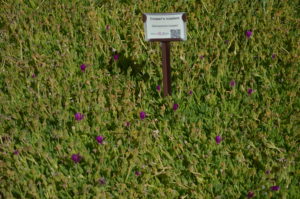Waterwise Grasses & Ground Covers
Choosing a grass or ground cover means weighing a number of factors, such as maintenance, durability, ease of installation, and in water-conscious California, water requirements are one factor that can never be overlooked. There are attractive, water-wise alternatives to traditional cool season turf that many Californians are used to. Look to low-water turfs, no-mow grasses, and other ground covers when you need to fill an expanse of flat ground with some low-growing greenery. Some grass varieties can tolerate little to no irrigation during dry months, and will go dormant and bounce back when rains return.
Low-Water Turfs
For a traditional lawn, consider the following tried-and-true turf grasses that, once established, are tough and tolerate low-water conditions:
- Red fescue (Festuca rubra): A low-maintenance, cool-season grass that does best in cooler climates. It requires a low to moderate amount of water once or twice a week and spreads slowly by rhizomes. It has a high tolerance for shade and can stand up to a moderate amount of traffic. Available in seed.
-
 Augustine grass (Stenotaphrum secundatum): A warm-season grass best suited for moderate climates. It does best in full sun but it can tolerate shade. It is available only in sod or plugs and requires water every three to six days.
Augustine grass (Stenotaphrum secundatum): A warm-season grass best suited for moderate climates. It does best in full sun but it can tolerate shade. It is available only in sod or plugs and requires water every three to six days. - California Field Sedge (Carex praegracilis): A short, rich-green sedge which can be left long or mowed, growing to 6-8 inches tall and forming a carpet that tolerates moderate foot traffic. It tolerates a range of soil conditions as well as full sun to partial shade but has a period of summer dormancy in warmer, drier climates. It is hardy in colder climates and can come back after below freezing temperatures. Moderate water requirements make this a good plant as a solid ground cover, or as part of a meadow like landscape.
For more information on turf grasses, check out the University of California Division of Agriculture and Natural Resources’ guide to turf varieties.
No-Mow Grasses
One option that is gaining popularity is no-mow grass, which creates a meadow-like blanket growing up to 1 to 2 feet high. You can mow a no-mow lawn if you wish, although it is recommended that you cut it no shorter than 4 inches. Different varieties are available, as well as seed blends that typically mix low-water fescues or native bent-grasses. Here are a few of the recommended low-water, no-mow grass varieties:
- Native California bent grass (Agrostis pallens): A bright green cool-season grass that can be installed as sod. Requires about half the amount of water of most lawn grasses.
- UC Verde buffalo grass (Buchloe dactyloides): Developed at the University of California, Riverside, this grass can be planted in plugs or as sod. It will go dormant in the winter in southern inland parts of the state.
- Pacific hair grass (Deschampsia cespitosa holciformis): Grows in dark green clumps up to about a foot wide. Can tolerate a wide range of conditions from little water to heavy water and full sun to part shade.
- Chewings fescue (Festuca rubra commutata): A dense meadow grass native to Europe. Can tolerate full sun to part shade and requires little to moderate water. Available in seed only.
Alternative Ground covers
There are many plants with a low-spreading habit that make a nice low-water lawn substitute. The non-grass options below can tolerate light foot traffic. Check out these possibilities:
 Iceplant: Many different plants get lumped under the common name “iceplant,” but it’s important to know exactly what you’re getting because Highway iceplant (Carpobrotus edulis) is invasive in many parts of the state and should be avoided. Smaller-leaved iceplants such as Delosperma cooperi and Delosperma ‘alba’ are fast-growing, low-maintenance ground covers that produce an eye-catching mat of bright pink or white blooms that bees and other pollinators love.
Iceplant: Many different plants get lumped under the common name “iceplant,” but it’s important to know exactly what you’re getting because Highway iceplant (Carpobrotus edulis) is invasive in many parts of the state and should be avoided. Smaller-leaved iceplants such as Delosperma cooperi and Delosperma ‘alba’ are fast-growing, low-maintenance ground covers that produce an eye-catching mat of bright pink or white blooms that bees and other pollinators love.- Wild strawberry (Fragaria chiloensis, F. californica): This drought-tolerant spreading strawberry can handle some foot traffic, but in areas where it isn’t trod upon, it will flower and produce edible fruit.
- Ceanothus (Ceanothus spp.): There are many cultivars of Ceanothus, but the low-growing varieties will slowly spread to fill an open space and cover it with tiny blue flowers. Ask your local nursery for the best varieties for your region.
- Woolly thyme (Thymus serpyllum): Gray-green leaves and pink flowers cover this low-growing, fragrant ground cover that is very attractive to bees and other pollinators. This is a good option for filling in around pavers.